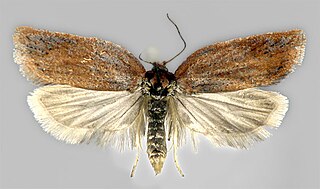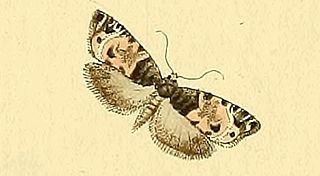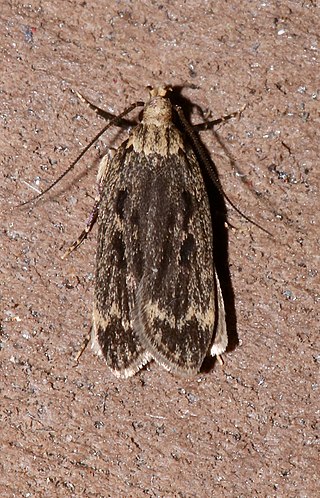
Notocelia uddmanniana, the bramble shoot moth, is a moth of the family Tortricidae. It is found in Western Europe and the area surrounding the Mediterranean Sea all the way up to the Caucasus, Kazakhstan, Iran and China.

Notocelia rosaecolana is a moth of the family Tortricidae. It is found in the Palearctic realm, where it has been recorded from China, Mongolia, Korea, Japan, Iran, Central Asia, Russia and Europe.

Epinotia tedella is a moth of the family Tortricidae. It is found in Europe.

Spilonota ocellana, the bud moth, is a moth of the family Tortricidae. It is found in the Palearctic realm, from North Africa and Europe to Iran, eastern Russia, China, Korea, and Japan. It is also present on Madeira and in North America.

Acleris rufana is a moth of the family Tortricidae. It is found from northern, central and south-western Europe through southern Siberia to the Russian Far East and Japan.

Eriopsela quadrana is a moth of the family Tortricidae. It is found in most of Europe, east to the eastern part of the Palearctic realm.

Cochylis hybridella is a moth species of the family Tortricidae. It is found in most of Europe, the Near East, China, Japan, Korea and Russia.

Epinotia tetraquetrana, the square-barred bell, is a moth of the family Tortricidae. It is found from most of Europe east to the Near East and the eastern part of the Palearctic realm.

Dichrorampha alpinana, the broad-blotch drill, is a species of moth of the family Tortricidae. It is found in almost all of Europe.

Gynnidomorpha alismana, the water plantain conch, is a moth of the family Tortricidae. It was described by Ragonot in 1883. It is found in most of Europe, except Spain, Switzerland, most of the Balkan Peninsula and Ukraine. Further east it is found across the Palearctic to China and Korea. It is found in riverine and other watery habitats.

Ichneutica pelanodes is a moth of the family Noctuidae. It is endemic to New Zealand and has been found in scattered locations in the North, South and Stewart Islands. I. pelanodes is easily confused with I. skelloni as the two species are visually extremely similar. In the North Island though the range of the two species appears not to overlap. Generally of the two species I. pelanodes tends to be darker in appearance. I. pelanodes inhabits wetlands but the life history of this species is unknown as are the host species of its larvae. Adults are on the wing from October to February and are attracted both to sugar and light traps.

Epinotia nemorivaga, the bearberry bell, is a species of moth in the family Tortricidae. It is found in Europe and Asia.

Eucosma aspidiscana, the golden-rod bell, is a species of moth of the family Tortricidae. It is found in China, Mongolia, Korea, Japan, Russia, North Africa and most of Europe. The habitat consists of woodlands, downland, waste grounds and cliffs.

Eucosma cana, the hoary bell, is a species of moth of the family Tortricidae.

Notocelia incarnatana, the chalk rose bell, is a species of moth of the family Tortricidae. It is found in China, Mongolia, Japan, Russia, Kazakhstan and Europe, where it has been recorded from most of the continent, except parts of the Balkan Peninsula.

Martyringa xeraula, the Himalayan grain moth, is a moth in the family Lecithoceridae. It was described by Edward Meyrick in 1910. It is found in India (Assam), western China, Japan and North America, where it has been recorded from Louisiana, Texas and from Florida to South Carolina.

Epinotia abbreviana is a moth of the family Tortricidae. It is found in Europe and was first described by Johan Christian Fabricius in 1794.

Ancylis unguicella is a moth belonging to the family Tortricidae. The species was first described by Carl Linnaeus in his landmark 1758 10th edition of Systema Naturae.

Pammene argyrana is a species of moth belonging to the family Tortricidae.

Epiblema costipunctana is a species of moth belonging to the family Tortricidae. It is native to Europe.




















